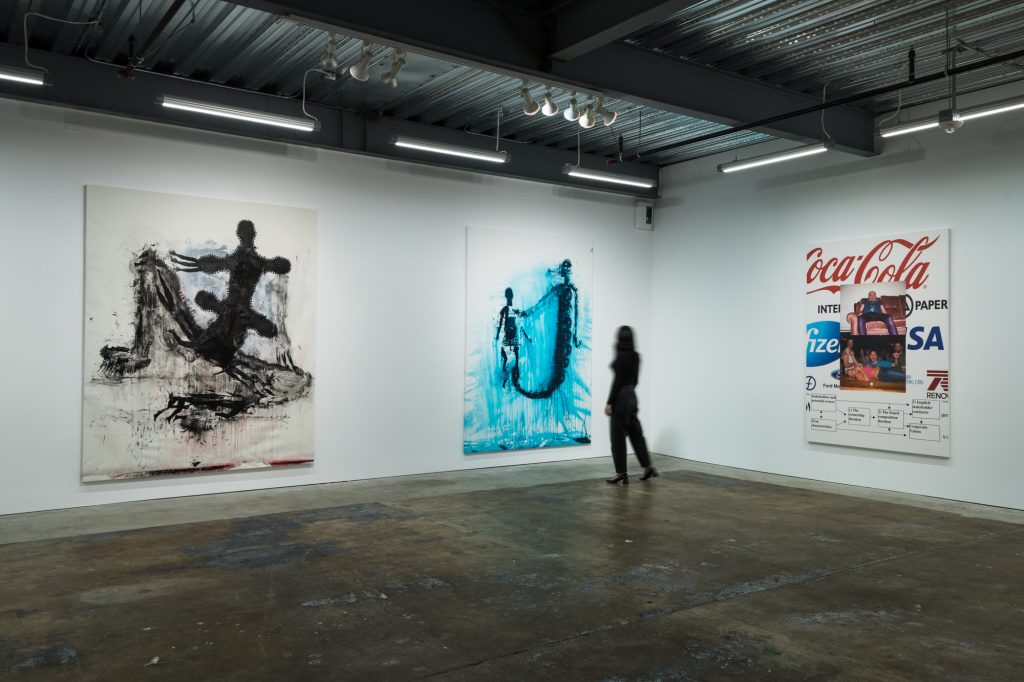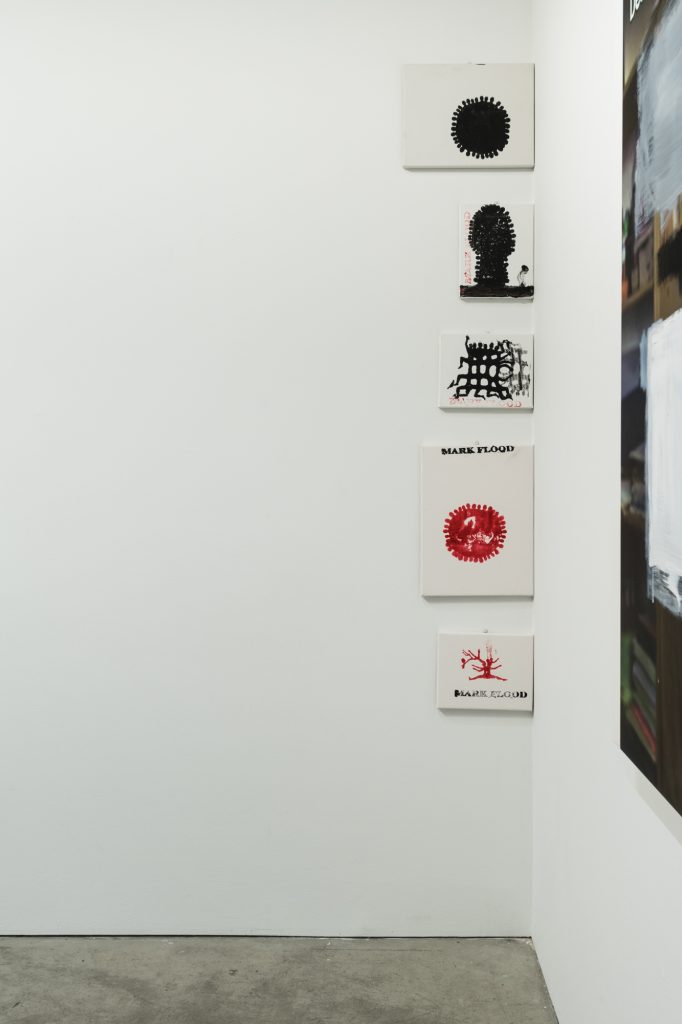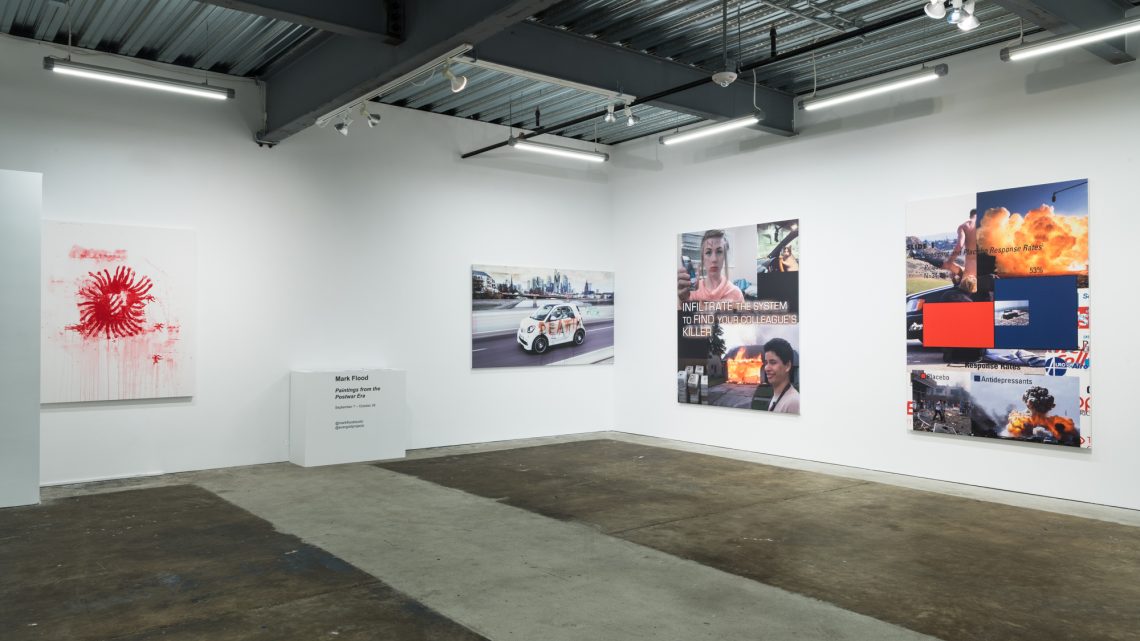Mark Flood
Paintings from the Postwar Era
September 7 – October 26, 2019
Reception: September 7, 5-8 pm
PDF copy of press release available here
Ever Gold is pleased to present Paintings from the Postwar Era, Mark Flood’s third solo exhibition with the gallery. Paintings from the Postwar Era features selections from the Heath series and the Monster series.
Mark Flood has been described as irreverent, a prankster, and a Canadian professional ice hockey defenseman. Some people seem to think that he is criticizing society, or maybe just the art world. Google him. He makes paintings, sculptures, films, videos, and music.
The Heath paintings are comprised of collections of internet images jumbled together on printed canvases—funny paintings for a world that has lost its sense of humor. They are funny but safe, because no one can really say what they mean.
The Monster paintings are hand-paintings on canvas of monsters—monsters of violence. These are paintings about violence in its most abstract form, for a world that is angry and bloodthirsty—paintings for those who want justice, revenge, violence and war but are unwilling to expose their own values, lest they end up on the guillotine.
Please contact info@nullevergoldprojects.com with any inquiries.

Mark Flood
Express, 2018
Acrylic and archival ink on canvas
47 x 84 inches

Mark Flood
Asteroid Revolt, 2018
Acrylic on canvas
60 x 60 x 2 inches
Artist’s Statement
Introduction
Yes, we seem to be in one of those yucky periods, like the early 1940s, in Armorica, where all the great art is so marginalized it’s not even on the game board,
[that is, the pre-cocoon caterpillar non-artists are ass-displaying on insta-whore, or simulating revolution on the Don, or earning cash on 4 chum, or drowning in a sea of nothing-like not-yet…]
and it never crosses people’s minds to look at it, or include it in the art category, let alone in the shit-eating, virtue-signaling biennial.
And conversely the stupidest, most ridiculous, preening crap
(preferably by Official Artists recently released from a legendary cell, so we know their art is really, really GOOD in the sense of Morality, like whole wheat bread for example)
is compulsively celebrated as if it were some propaganda masterpiece in Stalinist Russia,
Like it was, [“you” “know”], dingleberries from the anus of Marx/God itself.
So: it’s not a [burial suspicious], very auspicious time to have exhibits at all, but
What can you do? You take a little time off, and then return to the fray, and wait for the herd beast, She-woods, the Unproblematic, [because… blue-hair? Blurred chrome?]
To sufficiently digest, and shit out the little pellets of art poison,
[Remember? Like a rabbit in the cage?]
And then wait for the critics (Jerry, Roberta, Robespierre, Saint-Just) to cut one open, and for the intoxicating aroma to wake up two sufficiently snoring guys.
Paintings from the Postwar Era
Paintings from the Postwar Era fetishizes paintings that deal with the [parent boxes] paradoxes of Time, in these times, these difficult, word-violent times.
Many people believe we are on the verge of Civil War 2, and others think that we are in the middle of Civil War 2—that is, a civil war by other means, war by other memes, war by propaganda, war by words.
It is important for art to be always ahead, so these paintings are from the period after the Civil War. Thus, we can say that the paintings are later than anything else that happened, perfectly new, and a summary of everything that just happened, or might ever happen.
The Heath Paintings
The Heath series, named after the technical director of the series, Heath Flagvedt, was made 4 years ago, i.e. in the distant future of timeless art. But they were only recently unrolled, stretched and studied…
They consists of juxtapositions on canvas of compelling and unique “viral” images, “viral” in the sense of popular, selected from the passing internet soup, such as humans collected and stored on their indoctrination devices before the war.
These images are so old, so new and so far away in the future, that they are from eras when people still had senses of humor. This is in stark contrast to so-called “today”, when everyone is grim and judgmental, and human skeletons from the camps (both the Nazi labor camps of history, and the imaginary labor camps of the Terminator future) seek to guard consciousness from rapid apprehensions of reality/truth, which may occur in the form of a dangerous mental sneeze, so called “laughter.”
Ha ha ha, to the torture chamber. They also feature the logos of our corporate masters, in both hi- and nostalgic lo- res.
These arrays of logos function like the crates of crated dogs, a familiar cage that smells like one’s own familiar fear-piss, to which one can always return when one is uncertain, even when the door is open and weird freedom beckons.
In other words, collected images are juxtaposed on these canvases in ways that are theoretically “funny,” without being effable. Thus, it is impossible to describe what these paintings are about, or why they are humorous, which is the only safe way to avoid the Terror of Now, Then and Later, and especially Right Now, when one may be harshly and permanently judged for the wrong word choice.
The Monster Paintings
The Monster paintings show violence in its purest form. They represent violence performed by nameless, featureless monsters, without any real motives or reasons. They are absolutely anti-human monsters, but they display characteristic human traits. They destroy all human values in a brutal and psychedelic churn of atomized cultural debris.
All human art lovers can see both otherness and their own reflection in these monsters. They can see it as they dream about Civil War 2, prepare for Civil War 2, profit from Civil War 2, fight Civil War 2, kill and are killed in Civil War 2, recover from Civil War 2, or remember Civil War 2.
Or they may fail to make any connection between monsters of total violence and their own connection to Civil War 2.
Small decorative versions of the monsters of total violence are available.

Installation view, Paintings from the Postwar Era, Mark Flood at Ever Gold [Projects], San Francisco, 2019.

Installation view, Paintings from the Postwar Era, Mark Flood at Ever Gold [Projects], San Francisco, 2019.

Installation view, Paintings from the Postwar Era, Mark Flood at Ever Gold [Projects], San Francisco, 2019.

Installation view, Paintings from the Postwar Era, Mark Flood at Ever Gold [Projects], San Francisco, 2019.

Installation view, Paintings from the Postwar Era, Mark Flood at Ever Gold [Projects], San Francisco, 2019.

Installation view, Paintings from the Postwar Era, Mark Flood at Ever Gold [Projects], San Francisco, 2019.

N1H1 Virus, 2018
Acrylic on canvas
96 x 74 x 2 inches

N1H1 Virus (detail), 2018
Acrylic on canvas
96 x 74 x 2 inches

Installation view, Paintings from the Postwar Era, Mark Flood at Ever Gold [Projects], San Francisco, 2019.

Installation view, Paintings from the Postwar Era, Mark Flood at Ever Gold [Projects], San Francisco, 2019.

Installation view, Paintings from the Postwar Era, Mark Flood at Ever Gold [Projects], San Francisco, 2019.

Installation view, Paintings from the Postwar Era, Mark Flood at Ever Gold [Projects], San Francisco, 2019.

Installation view, Paintings from the Postwar Era, Mark Flood at Ever Gold [Projects], San Francisco, 2019.

Installation view, Paintings from the Postwar Era, Mark Flood at Ever Gold [Projects], San Francisco, 2019.

Installation view, Paintings from the Postwar Era, Mark Flood at Ever Gold [Projects], San Francisco, 2019.
